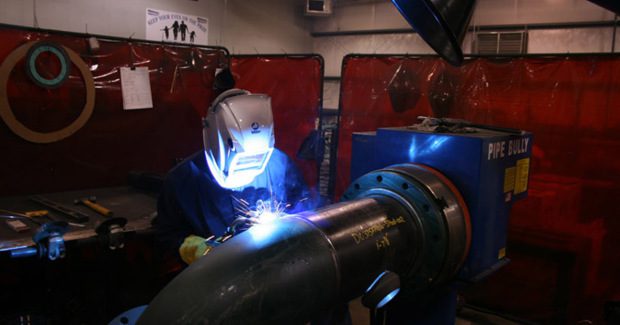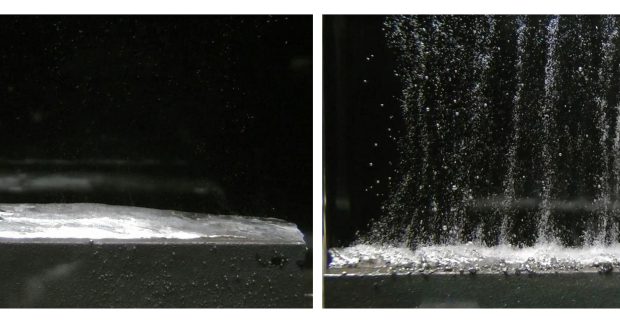Common Causes and Cures of Hydrogen Cracking
Knowing the means by which hydrogen can enter the weld is a good defense against potential problems. These steps can help reduce the risk of cracking that leads to costly rework, downtime, increased labor needs, poor productivity and most importantly, product failure.
Posted: December 3, 2014
Hydrogen is abundant in the earth and the atmosphere, but the element can cause significant quality and productivity issues when it’s present in the welding process. It can cause stress in the microstructure of the base material and weld metal, leading to hydrogen-induced cracking.
This cracking — also known as cold, underbead or delayed cracking — is a weld defect that can require costly repairs and rework. More importantly, hydrogen-induced cracking can be dangerous, as weld failures from this defect can lead to catastrophic events if they are not recognized before a part enters into service.
For manufacturers, fabricators or contractors welding on steel used in critical applications that require X-ray or code quality welds — such as structural steel erection, transmission pipelines, offshore platforms and process piping — it’s essential to control the presence of hydrogen throughout the welding process.
http://youtu.be/RixZQgp2QD4Take a look at how this induction heating technology can reduce hydrogen cracking in pipeline applications.
Let’s take a deeper look at the consequences associated with the presence of hydrogen and the methods for controlling it from start to finish in the welding process.
HYDROGEN IN THE WELD POOL
Hydrogen can enter the weld pool in a variety of ways. Typically, hydrogen picked up during the welding process is present in the form of moisture, which can come from humidity in the atmosphere or from mill scale, grease, oils, paint or other coatings on the base material.
Filler metals can also be a source of hydrogen. The dry chemicals and metal powders used as fill for metal-cored and flux-cored wires, as well as the flux coatings on stick electrodes, can be susceptible to moisture pickup that introduces hydrogen to the weld.
HOW HYDROGEN-INDUCED CRACKING HAPPENS
Because hydrogen is quite mobile when introduced into the liquid weld pool — especially at elevated temperatures — much of it can often diffuse out into the atmosphere. Once the weld has cooled, it is more difficult for hydrogen to escape, and the element tends to collect in the grain boundaries and the heat-affected zone (HAZ).
Over time, hydrogen collects in these areas and builds stress that sometimes is enough for hydrogen-induced cracking to occur. When hydrogen-induced cracking occurs in the weld metal, it is typically transverse to the weld direction.
Materials with higher carbon or alloy levels are especially prone to hydrogen-induced cracking, due to the presence of and propensity toward a more brittle or crack-sensitive microstructure, called martensite. Martensite can occur naturally during the steel forming process, resulting from the heating and cooling of the molten metal. It can also develop during welding, when the heat of the process can make the microstructure of the base material more brittle, especially if the weld has cooled rapidly. As carbon and alloy content increase, the chance of forming martensite also increases.
Typically, hydrogen-induced cracking occurs below 600 degrees Fahrenheit (more commonly occurring at or below 300 degrees Fahrenheit) and within 48 hours of completing the weld. In applications with greater contributing factors — highly restrained joints, high levels of hydrogen or rapid cooling after weld completion — hydrogen-induced cracking can occur much sooner, even immediately.
METHODS TO CONTROL HYDROGEN
Implementing methods to control hydrogen in the welding process can help prevent the rework, increased labor and material costs, lost productivity and quality issues that can result from hydrogen-induced cracking. Here are some key ways to control hydrogen in the weld:
- Minimize joint stress: Highly restrained joints can contribute to hydrogen-induced cracking because they are already naturally under stress, which can compound the other stresses caused by hydrogen in the weld and lead to cracking. When possible, design a joint to minimize stress.
- Use proper preheat and post-weld heat: Preheating and post-weld heat treating are critical ways to minimize hydrogen-induced cracking. Preheating can remove residual moisture in the base material, which would otherwise be a source of hydrogen, and it helps slow down the cooling rate after the weld is completed, which allows more time for the hydrogen to diffuse out of the weld. Similarly, elevating the temperature of the weldments after welding can help hydrogen diffuse more readily.
- Select the appropriate filler metal: Metal-cored and flux-cored wires and stick electrodes typically are available in low-hydrogen varieties. There is an optional designation for diffusible hydrogen that can be included in the American Welding Society (AWS) classification. Filler metals featuring H4 or H8 designators have passed tests proving that they deposit weld metal containing low levels of diffusible hydrogen. Stick electrodes can have an additional designation “R,” which means the electrode is resistant to absorbing moisture. Solid wires also offer low hydrogen levels since they have no fill material, and are therefore less susceptible to moisture pickup and hydrogen-induced cracking.
- Store and handle filler metals properly: Store filler metals in a dry area and in their original packaging until they are ready for use to reduce the opportunity for hydrogen pickup and prevent them from gathering other contaminants such as dirt or debris. The storage area should also be similar in temperature to the environment in which the welding will take place. Storing the filler metal in a cold area and moving it to a hot one can lead to condensation, increasing the chance of hydrogen in the weld. If a storage area of similar temperature is not available, allow the filler metal to acclimate to the temperature of the welding environment before opening the package.
Also consider the filler metal packaging. Heat or vacuum-sealed packaging is most likely to block moisture and hydrogen from the product, and tubular and solid wires are often packaged in this style of bag.
REDUCE THE RISK
Knowing the means by which hydrogen can enter the weld is a good defense against potential problems. These steps can help reduce the risk of cracking that leads to costly rework, downtime, increased labor needs, poor productivity and most importantly, product failure.
Subscribe to learn the latest in manufacturing.
















